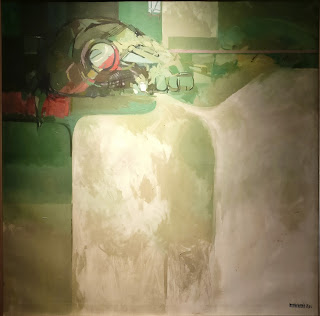Unreal GRUP (I): Dealing with Abstracts @ ILHAM
Two large institution exhibitions showcase abstract art within the context of Malaysian art history, which overlapping choice of artists and modern aesthetic offer much to see, but little to reflect upon. With 100+ paintings exhibited, Bank Negara Malaysia Museum and Art Gallery’s “The Unreal Deal” boasts “what is probably the largest ever display of abstract art in the country”, notwithstanding the absence of sculptures. Helmed by three relatively unknown curators, its display demarcated by decades project a lazy arrangement, exacerbated by dry catalogue essays keen on name-dropping and describing perceived styles. The thick catalogue bizarrely includes quotes by Edgar Degas and Francis Bacon, while the museum director’s statements that “(t)his is timeless and placeless art”, and “the definitive exhibition in its field”, compromise further my viewing experience.
 |
| Ibrahim Hussein – Freeze (1965) [@ Sasana Kijang] |
At ILHAM, “Gerak Rupa Ubur Penyataan 1957–1973” presents works by seven artists who participated in a 1967 group exhibition, i.e. GRUP, whom are now recognized as pioneers of Malaysian modern art. The timeline stated in the exhibition title, however, refers to a sideshow about the development of arts infrastructure, which exhibits are culled from “Manifest: Modernism of Merdeka” held at Galeri Petronas three months earlier. Worth noting also is the show “reGRUP – 30 years on” held at Valentine Willie Fine Art two decades ago, which gallery namesake is now the creative director of ILHAM. Within the exhibition, another sideshow features a collection of Latiff Mohidin’s “Pago-Pago” drawings – some belonging in Valentine’s collection – that coincidentally fits nicely with the exhibition’s curatorial theme to “…(trace) the emergence of modern art as a cultural phenomenon.”
 |
| Cheong Laitong – Malaysia Merdeka (1962) [@ ILHAM] |
In an interview with BFM, co-curator Simon Soon speaks about the emergence of the “full-time professional artist” during this time, thereby providing an instructive lens in viewing this exhibition. Wong Hoy Cheong wrote in the “reGRUP” catalogue essay, about “…a yard-stick for success is something less tangible – the artist as a mythical hero and art as a mystical venture. All the artists in the disbanded GRUP have cultivated this aura to varying degrees…” Between the lavish celebrity of Ibrahim Hussein (implied via ‘Paul’ displayed at the beginning of the gallery hang), and the poetic hippiness of Latiff (one known to trade-in works to maintain his livelihood in the late 1960s/ early 1970s), the remaining exhibiting artists attain social statuses via roles as art educators, bureaucrats, or in Cheong Laitong’s case, a lengthy career as the creative director of an international tobacco company.
Soft colours in Jin Leng’s dull paintings aside, mysterious qualities manifest in most exhibited artworks. I gaze into the cracks of Anthony Lau’s wooden ‘Spirit of the Fire’, and reflect upon the use of diamond shapes in constructing the metal ‘Cockerel’. Three of Lai Tong’s paintings diverge in style but united in its enigma – the dirty rough texture of ‘Bird Forms’ that recall Chen Wen Hsi, ‘Malaysia Merdeka’ and its sinister crevices, and the definitive brushstrokes depicting ‘Life, Public & Private’. Comparing Latiff’s oil painting ‘Tropika’ with its much smaller watercolour sketch, I notice the differences that bring into focus the artist’s ongoing attention, towards drawing the interior/ exterior of things. Hung opposite is the unexpectedly contemporary-looking ‘Mindscape IV’, its oblong-shaped cut-out depicting the silhouette of mobile phone screens.
 |
| Latiff Mohidin: [from l to r] Tropika, Kuala Lumpur (1968); Tropika (1969) [@ ILHAM] |
The calligraphic stroke is the subject matter in Syed Ahmad Jamal’s ‘Tulisan’, the most intriguing display at ILHAM. In Izmer Ahmad’s and Elham Shafaei Darestan’s enlightening essay The Calligraphic Subject: The Body and Social Power in Malaysian ‘Abstract Expressionism’, gestural expression (evident in many exhibits here) is described as “…rooted in an affirmation of social power that seeps into the body and animates the painter.” ‘Tulisan’ employs the naskh cursive Arabic script, found also on the Batu Bersurat Terengganu. Looking at the incongruous colours and crude marks, it becomes clear what the essay espouses is true, that “(t)he painter’s gesture on the canvas is proof of the body that is offered to ideological force of calligraphy that domesticates the body into a community.” One’s writing, is a product of one’s training, is a product of one’s ideology.
 |
| Syed Ahmad Jamal – Tulisan (1961) [@ ILHAM] |
“The painting does not present a recognizable symbol but appears to be what would generally be termed as expressive or spontaneous. It hardly resembles its prototype, the letter ج. (…) What is important is the act of painting the letter itself, hence the title Tulisan. This assertion seems to undermine the formalist ideology of the cursive script and convey a full authority of the painter over his ‘creation’. However, such view is nullified by the notion of ‘cultural habit’; what appears to be ‘expressive’ and ‘spontaneous’ notation is in fact a manifestation of a convention at work. The form that Tulisan assumes is grounded in a practice known among Islamic calligraphers as mashq, the disciplined scribbling or constant application of an interrupted movement. The act defines the foundation of calligraphy, for “the constant application of mashq improves the hand writing”.”
– Izmer Ahmad and Elham Shafaei Darestani. 2017. The Calligraphic Subject: The Body and Social Power in Malaysian ‘Abstract Expressionism’. Wacana Seni Journal of Arts Discourse 16: 35–68.


Comments
Post a Comment